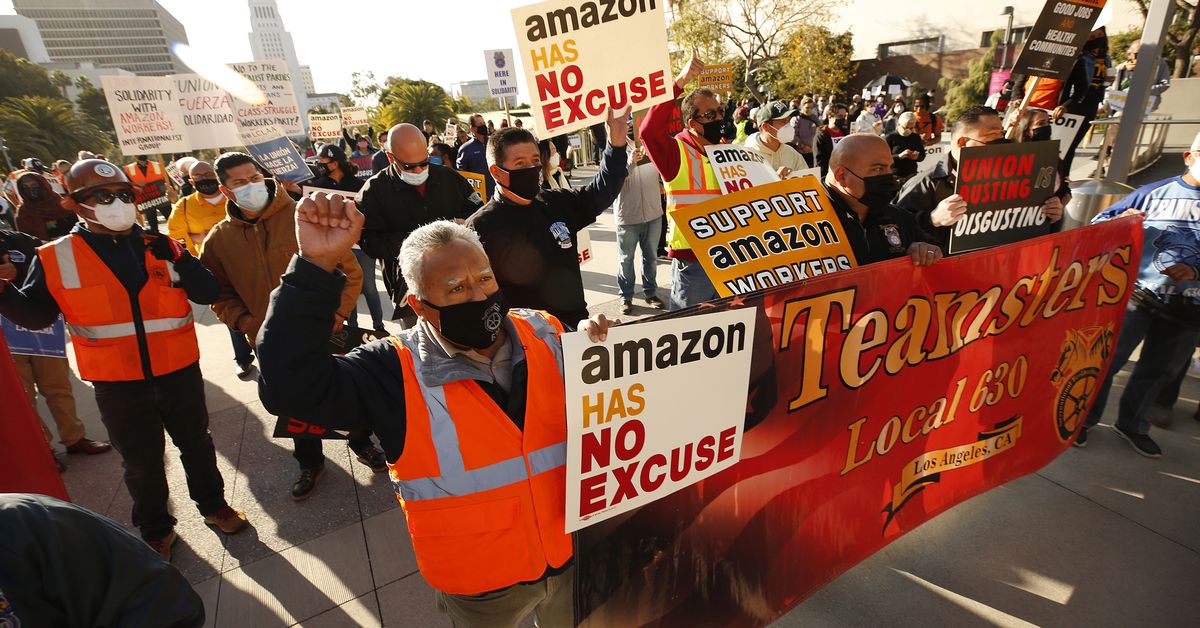Leaked internal memo reveals Amazon’s anti-union strategies
Teamsters Local 63 members join union workers to rally in downtown Los Angeles, California, in March 2021, to show support for unionizing Alabama Amazon workers. | Al Seib/Los Angeles Times via Getty ImagesInside the tech giant’s plan to neutralize...

In June 2021, the International Brotherhood of Teamsters, one of the most powerful unions in the world, published a “special resolution” about Amazon, labeling the tech giant “an existential threat” and vowing that “building worker power at Amazon and helping those workers achieve a union contract is a top priority.”
But inside Amazon, company officials were already preparing for battle, according to a leaked internal memo viewed by Recode and reported on here for the first time. The document, from May 2021, offers rare insights into the anti-union strategies of one of the world’s most powerful companies. The memo laid out two crucial goals for Amazon: establish and deepen “relationships with key policymakers and community stakeholders” and improve “Amazon’s overall brand.” The company has faced heightened scrutiny and worker activism in recent years amid reports of harsh working conditions and higher-than-average injury rates, resulting in a series of unionization attempts from Bessemer, Alabama, to Staten Island, New York.
“This engagement strategy is particularly important at this time given the International Brotherhood of Teamsters (IBT) attacks against Amazon, and its campaign to unionize our workforce,” the memo warned.
To achieve these goals, the memo proposed strategies to help Amazon boost its reputation and simultaneously “neutralize” company critics by befriending these critics’ own allies and by launching feel-good initiatives to turn the media and local politicians into company boosters. Amazon’s employee relations team was developing a separate “internally-facing strategy,” the memo said.
The document also offers an unvarnished look at how seriously Amazon perceives the threat of the Teamsters, which has more than 1.2 million members across industries, including logistics and warehousing, and whose leaders have vowed to disrupt Amazon’s growth plans as long as the tech giant opposes unionization efforts.
Teamsters General President Sean O’Brien told Recode in July that his union is intent on “disrupting [Amazon’s] network until they get to a point where they surrender” and stop resisting workers’ unionization efforts. One of the Teamsters’ main issues with Amazon’s employment model is that, for most of its front-line workers, “there’s no means to an end to a full-time career,” O’Brien said.
While the memo for the most part proposes strategies for Southern California, Amazon leadership saw it as a potential playbook of sorts to be utilized elsewhere, according to a source familiar with the strategy. If these anti-union tactics proved successful in California, which is a key logistics hub in the state most crucial to the company’s US operations, company leaders hoped to replicate the strategy in “hot spots” in North America, such as Boston and Chicago, where the company has faced heavy pressure and criticism from union organizers.
“As a business that delivers to neighborhoods across America, we work hard to strengthen our connections in the communities we serve,” Amazon spokesperson Paul Flaningan said in a statement. “We’re constantly exploring ways we can improve for our employees, our customers, and our community partners. That includes employees at all levels of the organization developing documents, engaging in planning sessions, and discussing different ideas — some of which get enacted, some of which don’t. Preparing for many different possible scenarios enables us to respond quickly to shifting business demands and external factors and one document should not be interpreted as a strategy or position.”
“I love the fact that we are [occupying] space in their head,” the Teamsters’ O’Brien said. “They should know we are coming.”
California beefin’
California was always destined to be a major battleground between Amazon and the Teamsters.
According to the internal company memo viewed by Recode, “California houses Amazon’s largest footprint in the world” and an employee base of more than 200,000 workers across a variety of warehouse formats and Whole Foods and Amazon Fresh grocery stores. Beyond that, Amazon also indirectly employs tens of thousands of other workers in California who deliver Amazon packages out of Amazon vans for small delivery firms that sign exclusive agreements with the tech giant.
:no_upscale()/cdn.vox-cdn.com/uploads/chorus_asset/file/23908099/AP21145589056426.jpg) Amazon tractor trailers line up outside the Amazon Fulfillment Center in Staten Island, New York, in April 2021. Representatives from the International Brotherhood of Teamsters, a union that represents 1.4 million workers, voted last year to make organizing Amazon workers a priority.Mark Lennihan/AP
Amazon tractor trailers line up outside the Amazon Fulfillment Center in Staten Island, New York, in April 2021. Representatives from the International Brotherhood of Teamsters, a union that represents 1.4 million workers, voted last year to make organizing Amazon workers a priority.Mark Lennihan/AP
For the Teamsters, the stakes are also clear: Amazon has been creating countless non-union jobs across industries in the US that are critical to the Teamsters’ survival, including warehousing, trucking, and package delivery, while simultaneously stealing potential growth from the Teamsters’ No. 1 employer, UPS. Perhaps as important is that Amazon’s success and size — it’s the second-largest private employer in the US — means companies try to emulate its practices, including wages and work conditions. That could make bargaining for better wages and work conditions tougher for Teamsters members.
Amazon staff acknowledged in the memo that the Teamsters’ “economic argument is ... currently stronger,” with union truck drivers, warehouse workers, and grocery store staff earning better or equal compensation packages as Amazon employees in the Southern California region the memo focused on. (A few months later, in September 2021, Amazon announced it had raised its average starting wage for front-line workers to $18 an hour, though many workers make less than that.)
Southern California, in particular, is a crucial logistics location for Amazon, its rivals, and the Teamsters, due to its population of 24 million people and two massive cargo ports in Los Angeles and Long Beach. Not surprisingly, “JC42,” the largest Teamsters US Joint Council — a collection of local Teamsters unions in a given region — is located in Southern California.
“While we see multiple threats to our business in Southern California,” the memo read, “of those threats, JC42 is exponentially greater than its peers.”
“Their organizing efforts will spill beyond the fulfillment center floor and the truck cab, and could interfere with Amazon’s ability to secure construction approvals, routing preferences, air expansion, and other core functions of our operation,” the document added.
Just a few months after the May 2021 memo warned of union interference, the Teamsters did just that in Oceanside, a Southern California community about 40 miles north of San Diego, “inviting community members to sign ‘commitment cards’ to stay engaged about an Amazon development,” Reuters reported. Soon after, the local city council voted against the Amazon project. And that’s just one example, as the memo noted.
“From Vista to Burbank to Cypress, we have run into opposition to our projects in communities traditionally viewed as business-friendly because we were late to engage with the community,” the memo warned.
The friend of my enemy is my … friend?
As a result, the memo proposed that Amazon should create and foster partnerships with local nonprofits and community organizations that company officials hoped would “provide political cover for local policymakers, neutralize organized labors’ attempts to grow their coalition of third-party validators and spokespeople, and provide a platform for Amazon spokespeople and allies to speak of the true economic and social impact of Amazon in Southern California.”
And not just any local nonprofits and organizations: Amazon shrewdly planned to “intentionally seek partnerships with some organizations that work closely with our opposition.” Those included organizations dedicated to helping incarcerated people find stable work upon reentry into society, such as the Anti-Recidivism Coalition, Homeboy Industries, and Defy Ventures, all named in the memo.
“The goal is to build a partnership that cultivates community leaders who will validate our work and engage in [a] public announcement and PR campaign that highlights Amazon’s true economic and social values,” the memo noted.
Alongside a mock press release announcing such a potential partnership, the memo listed what might be common internal questions for such a proposal, as well as candid answers. One question was, “How does this improve our corporate reputation?”
The answer: “While our wage and benefit offerings may go above and beyond entry-level offerings in other states, California’s minimum wage is about to hit $15/hour. By creating a pipeline of workers who would immediately benefit from our benefits compared to other peers in the region, we are creating spokespeople that can improve our reputation, while helping our communities most vulnerable.”
:no_upscale()/cdn.vox-cdn.com/uploads/chorus_asset/file/23908203/GettyImages_1228910422.jpg) Protesters rally in Will Rogers Memorial Park before marching to Amazon founder Jeff Bezos’s mansion in Beverly Hills, California, in October 2020. Genaro Molina/Los Angeles Times via Getty Images
Protesters rally in Will Rogers Memorial Park before marching to Amazon founder Jeff Bezos’s mansion in Beverly Hills, California, in October 2020. Genaro Molina/Los Angeles Times via Getty Images
Another question asked, “How will this earn Amazon Political capital, in regions where we are facing unionization efforts?”
“Much of Amazon’s opposition is aligned with policies and organizations who support social justice work and criminal justice reform like we’re suggesting here,” the answer stated. “Many former offenders do not qualify for federal benefits that could improve their lives and provide stability post incarceration. This allows Amazon to highlight our benefits offerings while creating safer, thriving communities.”
The document added that Amazon would likely need to alter its job candidate drug-screening practices if it wanted to develop such an initiative. Sure enough, a month after the memo was distributed internally, Amazon announced in June 2021 that it would no longer test most job candidates for marijuana, which has been legalized for recreational use in 19 states plus the District of Columbia.
Taken together, these proposals are an unsurprising but stark reminder that, as is the case with many corporations, Amazon’s public-facing actions are overwhelmingly in service of promoting or protecting the company, often in reaction to critics demanding that the company improve its labor practices. The billboards and TV commercials selling the narrative of Amazon as a great place to work, and the PR-friendly community partnerships in towns across the country where Amazon wants to set up shop, are developed for these reasons. Altruism this is not.
A school-to-Amazon-warehouse pipeline
Formerly incarcerated people were just one vulnerable group Amazon planned to work with to boost its reputation and fuel its expansion plans. It also strategized about creating hiring pipelines for underprivileged students and workers in lower-income communities in Southern California.
The memo proposed that Amazon seek accords with school districts in Southern California, such as the Los Angeles Unified School District (LAUSD), to create a continuous pipeline of workers for Amazon jobs from local community colleges. As of 2020, around 80 percent of families with children in the LAUSD live at or below the poverty threshold, and only 81 percent of students graduate high school in four years compared to 88 percent for California students overall. The memo said a school district partnership would support “some of Southern California’s most vulnerable students” — and such an effort would also help meet the company’s hiring needs by connecting full-time community college students with jobs at Amazon. If successful, the company would then seek to strike similar partnerships with the San Diego Unified School District.
In the Inland Empire region of California, which is especially critical to Amazon’s operations because it’s the state’s biggest logistics hub and the company directly and indirectly employs more than 40,000 people there, the memo proposed orchestrating an overhaul of workforce training programs in conjunction with city agencies and local community colleges. “The initiative will create pipelines for Inland Empire residents to access middle class careers that support homeownership, retirement savings, college savings and the building of generational wealth,” a mock press release said.
Messaging its efforts in that way would also help Amazon counter attacks from the Teamsters and other labor activists that focus on “lack of job growth and job security [at Amazon] as a reason to unionize,” the memo noted.
“This would be a partnership where Amazon’s current and future needs would be taught at city and educational institutions,” the memo added. Translation: Amazon wanted local municipalities and colleges to cultivate a pipeline of workers on behalf of the company, but in an arm’s-length fashion. Essentially, it would have the public sector promoting the needs of the private sector, all under the guise of benevolence.
Such a partnership would also address a looming problem for Amazon in the region: According to another leaked Amazon memo previously reported on by Recode, the company has projected that it could soon run out of workers to hire in the Inland Empire, due to increased competition from other employers and growing dissatisfaction among Amazon’s employees. (After initially declining to comment for that prior story, Amazon later said it was “hiring well” in the Inland Empire.)
:no_upscale()/cdn.vox-cdn.com/uploads/chorus_asset/file/23908120/GettyImages_1235434298.jpg) Workers sort out parcels in the outbound dock at the Amazon fulfillment center in Eastvale, California, in August 2021. Watchara Phomicinda/MediaNews Group/The Press-Enterprise via Getty Images
Workers sort out parcels in the outbound dock at the Amazon fulfillment center in Eastvale, California, in August 2021. Watchara Phomicinda/MediaNews Group/The Press-Enterprise via Getty Images
For all the promises Amazon planned to make to the low-income students and community members it sought to hire in Southern California, there’s a gap between those claims and reality for most of its workers. Most notably, the company’s narrative about how it offers middle-class careers to its employees seems to conflict with the company’s sky-high worker churn rates, which are regularly more than 100 percent. Workers in its warehouse network often don’t last long enough in their jobs to truly achieve stability through those roles. Those who do manage to build middle-class careers through Amazon warehouse jobs are typically the exception rather than the rule.
The positive optics of diversity
Beyond the partnerships aimed at boosting its hiring pipeline, Amazon also looked to enhance the company’s public image through sustainability projects, community beautification, and diversity, equity, and inclusion initiatives.
Amazon opponents, including the Teamsters, have leveled criticisms against the tech giant for the pollution around its warehouse and air cargo hubs, especially in lower-income areas such as the Inland Empire.
“This narrative continues to negatively impact [Amazon] Public Policy’s goals in the region,” the memo said.
As a result, the memo offered proposals that included prioritizing the launch of electric delivery vans in “communities of color” with high rates of air pollutants, and setting a goal of taking Amazon facilities in the Inland Empire region off the grid by 2030, powering them instead via hydrogen fuel cells.
The document also proposed investing in “improvements along iconic Crenshaw Boulevard” in Los Angeles as part of a Black community-led arts and infrastructure project called Destination Crenshaw, and to “consider announcing internal Amazon efforts that diversify our leadership” in conjunction with the investment.
“We will work across the business to partner with Destination Crenshaw and other community groups using the full breadth of Amazon’s resources — our creatives, our education programs, our small business investments — to not just have our name associated with a physical development, but so that the community sees Amazon as a company that is truly invested in their success,” the memo read.
Overall, the memo highlights the extent to which union-led criticisms are creating sizable obstacles to Amazon’s growth plans in its most crucial US market. But they also serve as a clear reminder that the company possesses vast resources to combat critics, and cunning strategies to portray reputation makeovers as corporate benevolence.

 MikeTyes
MikeTyes 
































